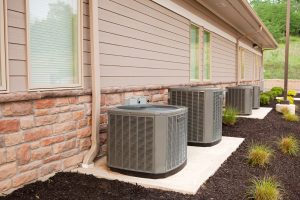 Summers in Oregon are invariably hot, but even worse than the high temperatures are high humidity levels that can turn our homes into steam baths. Air conditioners can deal with the problem somewhat, but they aren’t built to lower the humidity, only the temperature. Furthermore, high humidity can damage your AC as it tries to deal with the issue, as well as leaving your home muggy and uncomfortable in the extreme. That’s the bad news. The good news is that there’s an effective way to deal with it: whole-house dehumidifiers.
Summers in Oregon are invariably hot, but even worse than the high temperatures are high humidity levels that can turn our homes into steam baths. Air conditioners can deal with the problem somewhat, but they aren’t built to lower the humidity, only the temperature. Furthermore, high humidity can damage your AC as it tries to deal with the issue, as well as leaving your home muggy and uncomfortable in the extreme. That’s the bad news. The good news is that there’s an effective way to deal with it: whole-house dehumidifiers.
The Clean Air Act Blog: Posts Tagged ‘Wilsonville’
High Humidity Can Damage Your AC
Monday, July 24th, 20173 Signs That You Need a New Air Conditioner
Monday, May 15th, 2017 Air conditioners can last for many years, especially if you take good care of them with regular maintenance and judicious use. Sooner or later every appliance needs replacing, however, and that holds true for your air conditioner as well. If you’re going to replace it, now is the time, rather than risking a catastrophic breakdown in the middle of summer. But how can you tell if your system is ready to be replaced? Every AC is different of course, and only you can make the final call when it comes to its operating capacity. Generally speaking of course, there are three reliable signs that your system is ready to be replaced with a new one. If yours meets any two of them, you should think about having it put out to pasture before the temperatures get too warm.
Air conditioners can last for many years, especially if you take good care of them with regular maintenance and judicious use. Sooner or later every appliance needs replacing, however, and that holds true for your air conditioner as well. If you’re going to replace it, now is the time, rather than risking a catastrophic breakdown in the middle of summer. But how can you tell if your system is ready to be replaced? Every AC is different of course, and only you can make the final call when it comes to its operating capacity. Generally speaking of course, there are three reliable signs that your system is ready to be replaced with a new one. If yours meets any two of them, you should think about having it put out to pasture before the temperatures get too warm.
Install a Dehumidifier This Spring
Monday, March 6th, 2017 Snow has begun to turn to rain and before you know it, spring will be here again. With warmer temperatures comes a lot of wet weather, and humidity levels that can make your home feel like a swamp. Air conditioners can mitigate the problem somewhat, but it’s a very crude way to address the problem, and it places a lot of undue strain on the system. Far more effective is a dehumidifier: designed to remove the moisture throughout your house and provide a great deal of control in the process. Over time, it can extend the lifespan of your HVAC system and provide you with decades of reliable use in most cases. Here’s how it works.
Snow has begun to turn to rain and before you know it, spring will be here again. With warmer temperatures comes a lot of wet weather, and humidity levels that can make your home feel like a swamp. Air conditioners can mitigate the problem somewhat, but it’s a very crude way to address the problem, and it places a lot of undue strain on the system. Far more effective is a dehumidifier: designed to remove the moisture throughout your house and provide a great deal of control in the process. Over time, it can extend the lifespan of your HVAC system and provide you with decades of reliable use in most cases. Here’s how it works.
What Do to When Your Heater’s Warranty Runs Out
Monday, January 9th, 2017Every heating system comes with a warranty, which stipulates how long its various components are covered in the event of a breakdown. Specifics vary by the type of heating system, but most last for 10 years or thereabouts. That gives you some security when the system runs into trouble and keeps the costs of repairs limited. But what happens when the warranty runs out? What’s the best way to treat your heating system then?
Labor Day Is a Great Time for Heating Maintenance!
Monday, September 5th, 2016We usually mark Labor Day on our calendars as the last unofficial day of summer. After that, kids tend to head back to school and the fall season slowly settles in, though hot weather may persist for a few more weeks here in Wilsonville, OR. We like to use this holiday to remind our customers that cooler weather is right around the corner, and that they may wish to schedule a heating maintenance session sometime in the next few weeks. It makes sense in a lot of ways and could end up saving you a lot of money.
Stay Cool When Your AC Breaks Down
Monday, August 8th, 2016Hot summers are par for the course in Wilsonville, OR, and a reliable air conditioner can be your best friend when it comes to keeping your home cool and comfortable. No one likes to think about unexpected breakdowns and with regular servicing you can keep such risks to a minimum, but sooner or later, most systems suffer an unexpected shutdown. Once you’ve determined that the problem can’t be fixed by troubleshooting (say by checking the breaker box to see if the circuit break has been triggered), you need to shut off the system and call in a qualified air conditioning repair service. While you wait for them to arrive, it’s very important to stay as cool as you can. High heat is nothing to toy with, and these steps will help ensure you can wait it out as painlessly as possible.
Signs of Fan Motor Problems with Your AC
Monday, July 4th, 2016With summer in full gear here in Wilsonville, OR, you need to be extra vigilant to detect any potential problems with your air conditioner. A sudden breakdown could leave you in the lurch just when the temperatures are really soaring, and in many cases, that could prove a health risk as well as any other concerns. The more you know about potential problems with your AC, the more quickly you can respond.
Troubleshooting Air Conditioning Problems
Monday, April 11th, 2016With temperatures warming up here in Wilsonville, OR, you’re likely using your air conditioner more and more often. If a problem arises, you want to take care of it quickly before the heat of summer sets in. But those circumstances, however, it pays to slow down and do a little checking first. An air conditioner that won’t turn on or one that seems to be malfunctioning may actually have a very easy solution to the problem. It pays to troubleshoot first, before you call in a repair technician. That way, you can at least be assured that the problem is worth paying a professional to look at.
Signs of an Oversized Furnace
Wednesday, December 7th, 2011Most people, when they choose a new furnace for their Wilsonville home, think that “bigger is better”. However, an oversized furnace can present just as many if not more problems than an undersized furnace. So, if you feel you may have overdone it in the past or you want to avoid making a mistake in the future, here are some signs that your furnace may be oversized.
Short Cycling
The most common sign of oversizing is short cycling. Short cycling occurs when your furnace turns on and off frequently because it reaches the thermostat setting so fast. Basically, your furnace is so powerful that it can produce what you need rapidly and then shuts off. But, because it does this, the temperature in your home is likely to cool much faster as well since the furnace isn’t on all the time.
Additionally, the on and off short cycling has a negative effect on your furnace, causing excess wear and tear on the system and eventually leading to extra repairs and in some cases early replacement.
High and Low Temperatures
When your furnace is turned on for a comfortable indoor temperature like 70 degrees F, the high and low temperature between cycles should be relatively close to that temperature. In an ideal situation, you shouldn’t even notice a fluctuation.
So, if the high temperature gets close to 75 degrees F and the low temperature is around 66 degrees F, you have a furnace much too large for the size of your home.
Furnace Room Issues
You might find that the space and exhaust given for the furnace are not sufficient either, especially if your previous furnace was replaced with this oversized unit. Backflow of a gas or oil smell or excess heat in and near your furnace room are both common signs that the furnace is much too large.
So, what should you do about your oversized furnace? If you have had that furnace for some time or just moved into a new home, it’s a good idea to have a new one installed. Have a proper load calculation done and then get a new furnace installed so you don’t have to worry about the system cycling on and off so often. If it’s a newer unit, call your heating technician and discuss possible options to reduce the negative effects of the miscalculation of its size.
Common Furnace Problems
Friday, October 14th, 2011When it comes to your Colton home’s furnace, you simply want it to work all of the time. But just like any other piece of equipment, your furnace will have problems from time to time. A few of these are relatively simple to fix on your own, but for the most part you’ll need to call in someone to take care of the repairs for you.
However, before you can do that, you’ll need to recognize that a problem exists at all. And the earlier you notice the warning signs, the better off you’ll be. It’s always better to get a furnace problem taken care of right away than to wait until your furnace stops working completely.
It’s also good to remember that quite often the problems you’re having with your furnace are really originating with your thermostat. This is usually welcome news, as thermostats are much cheaper and easier to repair and replace than many other parts of your furnace. In fact, even if your furnace isn’t working at all, it may only be the result of a faulty thermostat.
Another problem you may start to notice is that one part of your house is being warmed more than another part. When this happens, it can be a sign that there is something wrong with the furnace, but it may also be that the pressure in your duct system is not balanced properly. A simple rebalancing of this system can have your house heating evenly again in no time.
You may also realize that your furnace seems to be cycling on and off too often. When a furnace is working properly, it will come on for a considerable period of time and then shut off until the temperature in the house drops below the desired level. However, some problems can cause your furnace to complete many short cycles rather than fewer short ones.
If this is happening to your furnace, there are several possible causes. Something might be wrong with the blower on the furnace or the thermostat might not be feeding the furnace the correct information. Another possibility is that your furnace’s air filter is dirty or clogged.
While there are sometimes simple and straightforward solutions to these types of common furnace problems, it’s best to call in a professional to have them take a look if you’re not sure where to start searching for a problem. In most cases you’ll need them to come out and make the necessary repairs anyway.
